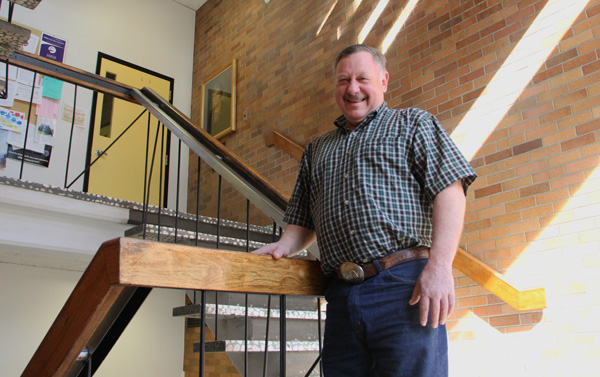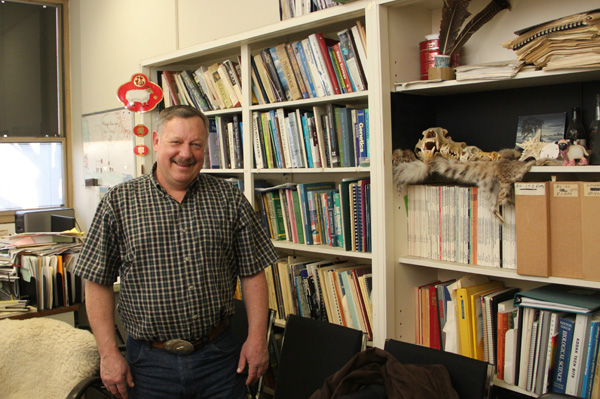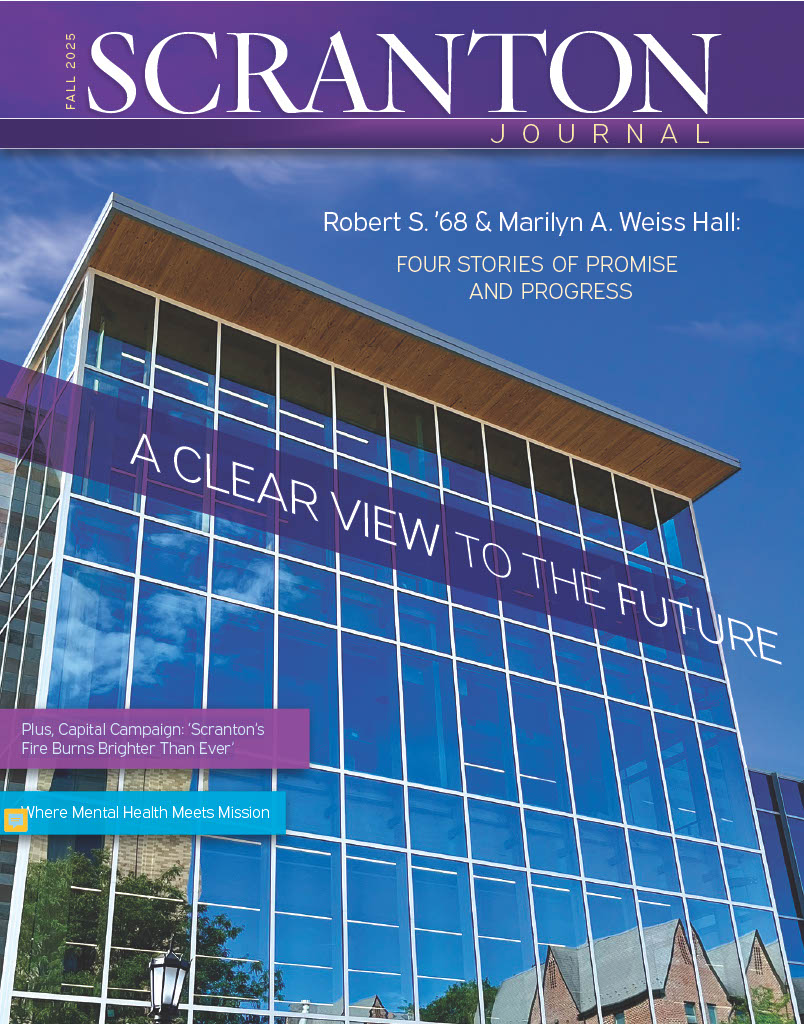Michael A. Hardisky, Ph.D., provided us so many good answers, we couldn't fit it all in The Journal's print edition! Check out our expanded interview with him below. The purple indicates additional responses and questions found only here!
Title: Professor of biology
Years at Scranton: 28 years
Hometown: Tunkhannock
Family: Two sons, Michael ’00, G’02 and Andrew ’01, and twin daughters, Denise ’09 and Dana ’10 – all four are involved in the health or life sciences fields: a biology teacher, a practicing veterinarian and two veterinary students
Hobbies/Interests: Raising sheep, a lot of sheep
Most Remarkable Place You Have Visited: Bethel, Alaska, which is located on the state’s western shore and is near the Arctic Circle. “The remoteness of the area was just incredible,” he says. “One day while we were there we hired a pilot to take us to a stream to fish for salmon. What I remember was the water. It was so clear and so pristine.”
Q&A
1. You were named Teacher of the Year by the Class of 2011. What does it mean to you to be honored by the students?
To me, it’s the highest honor because they are the ones in class with you every day. They are the ones who can best evaluate what you do. It’s pretty significant to me because the reason I am here is to help them achieve their goals. So, for the students to present me with that honor meant a lot.
2. Having joined the University’s Biology Department in 1984, describe what the campus was like when you arrived?
To be honest, it seemed pretty small. It really did. It feels like since I’ve been here, they have built a new building every year. It’s funny. Part of the reason they got me to come here was that the school said they were going to build a new science building – in 1988. [Laughs.]
3. What’s the most important lesson a student should learn from your biology class?
I tell students this frequently, there is always a way to get to where you want to go. There may be the traditional way, the way people think is the easy way, but if things happen – and they do – you can still always achieve your dream. I try to make sure that students know that because, if they have a bad semester or run into some other difficulties, there is always a way to recover from those setbacks.
4. What’s the secret to getting an A in your class?
You just have to work hard. I try to be very straightforward with students. I don’t like playing games, and they know that. A lot of courses are just a lot of material, and they just have to buckle down. Freshmen often come in and they still have that high school mentality that they are going to study the night before and be OK. Then they get a 20 on the test. But they do develop the right study habits by the time they become underclassmen.
5. You are currently involved in researching the production of biofuels from vegetation. Explain your interest in biofuels.
When you fill your car up with gas, you know that 10 percent of it is ethanol. That ethanol is being produced by fermenting corn – making moonshine. That’s what they are doing. The problem I have with that is the ethanol production increased in this country and my sheep feed went through the roof. In fact, it doubled. And so, I guess I have an ethical dilemma. I have a problem with using food for fuel. This is food that humans can consume or that livestock can consume. Now we are taking that food and using it to make fuel. My desire is to use alternative crops as a source of sugar to make ethanol.
The alternative crop I’d like to use is sorghum, which looks like a corn plant, but it does not have an ear. It has seeds. In the old days, farmers used to plant sorghum in their cornfields when they chopped the corn to make silage for their cattle. It tasted better because it had those sugars. Our thought was to use sorghum and not to grow it in agricultural fields, but in greenhouses. You could put a greenhouse on top of a building. You can take urban areas that have come dilapidated and put up greenhouses. You can use areas other than prime farmland to make ethanol. That is where my interest came from.
6. You involve of your students in research work and grant activity. How valuable is this hands-on experience for students?
It’s interesting, my research has always been plant oriented and we do remote sensing, we use satellite images and hand-held instruments to measure light reflected from canopies. I’ve had so many pre-med students involved with that research, and it’s a far cry from what they will do in their careers, but it exposes them to problem solving in the sciences. And that is what they will do every single day of their life as a physician. They will be presented with data, they have to put it in a context of what they are working on and then they will have to come up with some conclusion. And that is exactly what research makes you do. The best part of research is that you are working on something and then it all goes wrong. Then you have to figure out how to make it right. It makes students think about the process and they think about the principle that they are studying. You have to go back to the basics and then make modifications.
7. You earned graduate degrees at the University of Delaware in ocean engineering and marine studies. Obvious question: What’s the best way to prevent seasickness?
Take medication. [Laughs.] I remember working on a research vessel, it was called RV Wolverine and it had a narrow beam – that’s the width of the boat. Well, we would get out on the Delaware Bay and those waves would come up and – because it had such a narrow beam – it would rock back and forth. Man, I was sick all the time.
8. What is your favorite place on campus and why?
Probably the one place I frequent is the Rev. G. Donald Pantle, S.J., Rose Garden. Even though there is a lot of hustle and bustle around it, the walls sort of keep it out. It’s just a quiet place.
9. What’s the best part of the new Loyola Science Center?
The teaching labs are really outstanding. The way the rooms are designed, the students can see a center console. Everything is computerized to enhance the learning process. It takes away the mechanics, the things we got wrapped up in when I was a student. This allows the students to focus on the process that we are studying. It really makes the learning process easier on both sides. It enhances the learning process and you can focus on learning the principle and not worry about the manipulations.
10. What will you miss about the Loyola Hall of Science?
I have always been mesmerized by the pebble steps in here. I have never seen that anywhere else. I can remember the first time I came in here to interview and mentioning it. I guess I will miss that. If they ever tear this building down I will probably buy a step. [Laughs.] But don’t get me wrong, it’s been a good building.
11. You have served on University’s Health Professions Evaluation Committee for many years, assisting students on their path to medical school. What’s one area often overlooked when applying to medical school?
Everybody is focusing on grades, but I like our students to be unique. One of the aspects of uniqueness is experience – particularly experiences with different cultures. I think that gives students a tremendous advantage when they are applying for professional schools because it shows they have knowledge of other ways of thinking and an acceptance of other ideas. I think these are exceptional traits for someone who will provide services to a diverse population. I tell our students, don’t neglect outside activities. If you have a chance to study aboard, go. If you have a chance to go to El Salvador for a service trip, go. If you feel like going to do service for a year before you start med school, go. Those experiences center you. They put your life in perspective.
12. In addition to being a full-time professor, you run a 100-head sheep farm in Nicholson. How do you juggle both?
Well, January and February are the busiest times of the year. We have about 65 sheep that we are lambing then. And then I have another 20 that will lamb in May and June. If I lamb mostly in January, and in the beginning of February, the hard stuff is done before the semester is really crazy.
13. Do sheep have different personalities?
Oh, yes. Absolutely. They are all different. There are ones that want to jump on you. There are ones that want to crawl under the fence. There are all kinds of behaviors that are unique.
14. In addition to being actively involved in 4-H, you are board member of the Tree of Life Rescue, a nonprofit organization that plans to rescue farm animals and preserve farmland in Wayne County, Pa. Why is this mission important to you?
I like to be a part of organizations that preserve farmland. Small farms are on their way out. There is no way from an economic standpoint that they can survive. But if we can keep the landscape in a semi-natural state, so that we get the normal ecological functions, there are so many benefits.
15. You oversee the Biology Department’s annual pig roast. Tell me a cooking tip or two for roasting a pig?
A good wood fire and my super secret sauce. [Laughs.] Every good cook has his own super secret sauce. I make the sauce and nobody seems to complain. How’d I make it? I looked at a lot of different barbeque recipes and I just took the components that I liked and combined them.






